Data centre cooling is a continually evolving science, and among the plethora of cooling methodologies, is free cooling, the most effective regarding both cost and application.
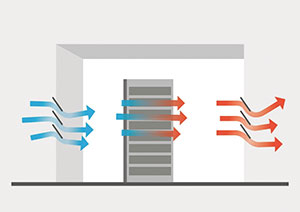
Power ranger
Data centres consume almost as much energy for non-computing resources as they do in powering their servers. That is why Power Usage Effectiveness (PUE) is so important – the closer it is to 1.0 then the better the management of non-computing energy – and free cooling can reduce this figure.
Gartner defines free cooling as ‘any technique used to reduce the energy consumed by cooling systems or the time that the cooling units run by using the outside temperature of air or water to cool the data centre or other facilities.’ In essence, free cooling helps save energy.
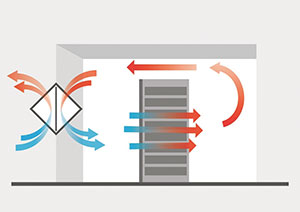
Temperature gauge
There are various measurable temperatures present in a data centre, including supply air, return air, room air, cold aisle, and server inlet and exit temperatures. Server inlet temperature and server exit temperature both have a significant effect on cooling system efficiency and the higher the former, the more efficient the cooling system.
These openings and ductwork bring a security risk to the data centre and as such, the system must have the ability to operate independently of the air inlet.
Today’s modern data centres supply air temperature is the main control parameter, and is typically set between 18-27˚C, as recommended by ASHRAE TC9.9, resulting in return air temperatures to the cooling equipment of 25-40˚C.
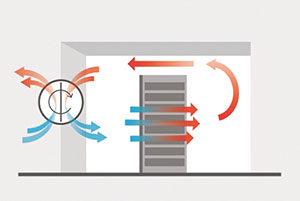
Indirect free cooling
With indirect free cooling, no outside air enters the data centre and CRAC systems can be configured to suit requirements. However, indirect free cooling is theoretically less efficient than direct free cooling, as at least one heat transfer must always take place between the air in the data centre and the outdoor air.
Single stage indirect free cooling is based upon an air/water heat exchanger placed on the hot water return of the chiller. Outside air is blown across the heat exchange, removing heat before it reaches the chiller. Therefore, with a return water temperature of 20˚C, if the outside temperature is >19˚C, it reduces both chiller activity and running costs.
Two stage indirect free cooling systems have a smaller footprint but are less efficient, functioning with two heat transfers. In the first heat exchanger, the heat from the air in the data centre is transferred to a liquid which is pumped to the outside in relatively small pipes, where heat from the data centre is rejected to the outdoor air via a second heat exchanger.
Indirect dynamic free cooling
To further improve efficiency, dynamic technology controls the mode according to the current heat load in the data centre, and increasing the time in free cooling mode. The extended free cooling operating mode lengthens operational time and drastically reduces operating costs.
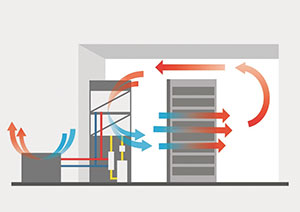
Direct free cooling
With direct free cooling, filtered outside air is fed into the data centre if it is the right temperature. This means the compressors do not operate as often, saving electrical energy.
In urban areas, air quality can be poor and full of particles, which is damaging to modern IT equipment. Therefore, direct free cooling should only be used if filtering can control the air quality.
Also, if the outdoor air is too cold, a certain proportion of warm air from the data centre must be mixed in to make controlled, tempered air.
Humidification must also be controlled, though this can be expensive and complex. In addition, large openings in the building fabric are needed to bring outdoor air in, plus an equally large ductwork system and fabric opening is needed for the exhaust air.
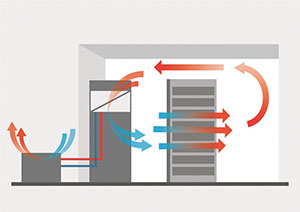
Liquid asset
Air contains a certain amount of water and the total amount depends on the air temperature and barometric pressure. Water absorption into the air causes an adiabatic process takes place – whereby air temperature decreases but it’s energy content remains unchanged. By using adiabatic assistance in direct free cooling systems, the air is cooled before entering the data centre. Indirect free cooling and adiabatic assistance is more conducive however, as the adiabatically assisted outdoor air never enters the data centre.
In single stage indirect free cooling systems, adiabatic assistance reduces the temperature of the outdoor air entering the air/air heat exchanger and reduces the amount of mechanical cooling required.
In two-stage indirect free cooling systems, the warm outdoor air can be cooled by adiabatic assistance before entering the dry cooler to either increase the hours of usable free cooling, or extend the mixed mode at the upper limit to reduce the use of mechanical cooling.
Final
As the density of installed equipment in the data centre has risen, so too has the amount of heat generated and the need to control temperature has led to free cooling usage popularity. No free cooling system is perfect though, and all have limitations. It is therefore important to evaluate what kind of free cooling is best suited to the application on a case-by-case basis.
T 01372 749666
www.stulz.co.uk
